Related Content
- Jurisdiction
- Equitable Jurisdiction
- Venue
- Class action
- Class Representative
- Individual plaintiffs
- Defendant Scottish Power
- Defendant PacifiCorp
- Defendant PPM Energy Inc.
- Scottish Power and commercial wind power development
- Defendant Greenlight Energy Inc.
- Sale of Elk River Windfarms LLC
- Defendant The Empire District Electric Company
- The Empire District Electric Company and the Elk River Project
- The Flint Hills Ecoregion
- Flint Hills Endangered Flora & Fauna
- The Native Prairie Grasslands
- Tallgrass Prairie National Preserve
- Legislative History: Tallgrass Prairie National Preserve
- The Konza Prairie Site
- The LTER Program
- The Prairie Parkway
- The Flint Hills Scenic Byway
- Flint Hills Scenic Resources
- International recognition of the Tallgrass Prairie
- Birds of the Tallgrass Prairie
- Tourism
- Beneficial impacts of tourism
- Economic impacts of tourism
- The Blue Ridge Parkway Experience
- Serious, permanent & irreparable damage
- Wind turbines kill birds of prey
- Wind turbine development destroys habitat
- Wind turbine development damage
- Damage to quality of life
- Wind turbines: an economic catastrophe
- Tax avoidance and subsidies
- Voodoo economics of wind turbine power
- Catastrophic wind turbine failures
- The Electric Power Grid
- The prayer for relief
Serious, permanent and irreparable damage to the Economy
151. In addition to the high cost of what little electric power may be generated by industrial wind turbine commercial electric power generation facilities, and the serious, permanent and often irreparable damage to local and regional environmental and ecological systems and viewscapes with resulting permanent damage to real property values, industrial wind turbine commercial electric power generation facilities owned and/or operated by wind energy speculators such as the corporate Defendants in this action create a net outflow of wealth (dollars) from the people of Kansas.
It is all about tax avoidance and subsidies
152. Tax avoidance not environmental benefits or energy independence has become the prime motivation for the frenzy among wind energy speculators to build industrial wind turbine commercial electric power generation facilities as quickly as possible regardless of whether there is any economic justification for such facilities. This system of tax credits and subsidies leads wind energy speculators to sweep environmental siting considerations aside in their frantic pursuit of economic rewards without risk—something for nothing.
153. Industrial wind turbine commercial electric power generation facility owners enjoy two very generous federal tax breaks: five-year double declining balance accelerated depreciation and a Production Tax Credit for each kWh of electricity produced during the first 10 years the giant turbines spin regardless of whether the electric power produced provides any benefit to the hard pressed consumer of electric power or the businesses that run on electric power.
154. Since most states conform their state corporate income tax to the federal system, the five-year double declining balance accelerated depreciation can also be deducted from otherwise taxable income in the state the industrial wind turbine commercial electric power generation facilities are located thus reducing the owners’ corporate tax liability in that state.
Renewable Portfolio Standards-Shifting Costs to Consumers … Again
155. A “Renewable Portfolio Standard” mandates some minimum amount or percentage of electricity that a distribution company would have to produce or purchase and make available to its customers. The “mandate” would have to be met even though electric power produced from “renewable” sources was substantially more costly than electric power form “traditional” sources.
156. Renewable Portfolio Standards (mandates) benefit wind energy speculators at the expense of electric power consumers in violation of the Constitution of the United States.
157. Renewable Portfolio Standards are one of the most insidious ways yet developed to shift costs from developers of industrial wind turbine commercial electric power generation facilities to ordinary electric power consumers and to hide those costs in monthly electric bills.
The Production Tax Credit
158. The wind “Production Tax Credit” which allows the owner to deduct from federal income tax liability $0.018 per kWh of electric power produced commercially during the first 10-years of the project life. Although this tax credit expired at the end of 2003, it was recently renewed by the United States Congress to restore the credit.
159. Various other subsidies shift large amounts of cost from industrial wind turbine commercial electric power generation facility owners to ordinary taxpayers and electric customers.
160. States also permit local governments to exempt industrial wind turbine commercial electric power generation facilities from some portion of the property taxes that would normally be paid. In Kansas the wind energy speculators pay no property taxes at all!
161. Tax breaks provided to owners of industrial wind turbine commercial electric power generation facilities shift and transfer the tax burden those owners escape to ordinary taxpayers unjustly enrich the owners of industrial wind turbine commercial electric power generation facilities at the expense of all the other people of the United States who consume electric power all in violation of the Constitution of the United States.
162. In addition to unconscionable tax benefits, the owners of industrial wind turbine commercial electric power generation facilities receive the revenue from the sale of the electric power that is produced.
Guaranteed Markets
163. In some states there is a virtually guaranteed market for electric power produced from industrial wind turbine commercial electric power generation facilities due to the State’s “Renewable Set Asides” requirement applicable to investor owned utilities and a “Mandatory Green Power Option” applicable to all utilities.
164. These additional markets resulting from mandated purchases of “green electric power” by federal and state government agencies at above market prices cover these increased operating costs by reducing other agency services and programs.
165. State programs requiring or encouraging electric utilities to offer “green” electric power at premium prices, seldom attract enough “volunteers” to pay the utilities’ costs of buying the “green” electric power and administering the program. The cost not recovered from customers paying premium prices is spread among all the other consumers of electric power.
166. The wind industry has ready access to and support from Department of Energy (DOE) officials who control the flow of tax dollars for renewable energy programs, as well as National Renewable Energy Laboratories and other Department of Energy contractor employees who use taxpayer dollars to aid the wind industry’s lobbying and public relations efforts. These officials and employees actively participate in the development and distribution of biased “studies,” “analyses,” and “reports” that overstate the benefits and understate the true costs of wind energy. Their actions suggest that their loyalty is to the interests of the wind industry, not those of taxpayers and consumers.
Wind energy speculators and their “Wind Industry”
167. In spite of subsidies and favorable tax incentives, wind power represents a de minimus portion of United States energy production.
168. Fossil energy sources—coal, natural gas, and petroleum combined—are expected to supply 84.73% of United States energy requirements in 2025 according to the United States Energy Information Agency. That is 212 times the 40/100 of 1% expected from wind.
168.1 The following table was taken from an official statement of the United States Energy Information Agency.
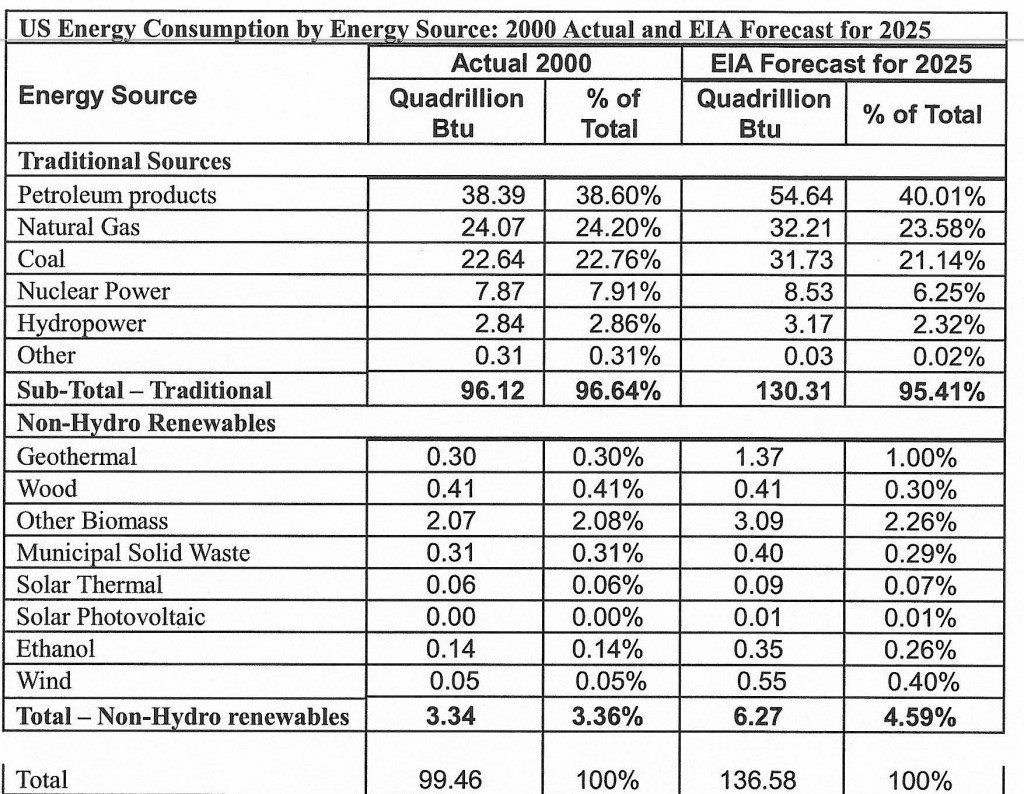
168.1 United States Energy Information Agency 2025 forecast
Windfalls and wipeouts
170. Economic analyses indicate that the extra cost to electric power consumers will far exceed the income received by the few landowners who might be willing to lease their land for erection of industrial wind turbine commercial electric power generation towers and it would be more economically rational for the electric power consumers to pay the landowners not to allow industrial wind turbines to be built upon their land!
171. The big “ winners” are the owners of industrial wind turbine commercial electric power generation facilities; electric power consumers and local
taxpayers are the big “losers.”
172. The big “losers” when industrial wind turbine commercial electric power generation facilities are built are the electric power consumers who pay the higher true cost of the electric power produced and the local and regional taxpayers who absorb the tax burden escaped by the owners.
The voodoo economics of wind turbine electric power generation
173. The United States has been, is now, and will almost certainly continue for the next few decades to be heavily dependent on coal, petroleum, natural gas, hydropower and nuclear energy to meet our energy requirements.
174. Despite the hundreds of millions of tax dollars spent on R&D and the other generous subsidies, there is no significant probability that wind will make a significant contribution toward meeting United States energy requirements.
175. Federal and state government actions designed to force greater reliance on wind distort capital investment and the very structure of the American Free Enterprise System by steering capital to projects that have little economic merit.
175.1 The greater share of the capital investment in industrial wind turbine commercial electric power generation facilities goes for turbines, blades, towers, electronics and related equipment which are produced in other states and, often, foreign countries. Little of the money for equipment and supplies is spent locally.
176. The generous federal and state tax breaks and “Renewable Portfolio Standards” produce significant transfers of wealth from taxpayers and electric power consumers to wind energy speculators.
Overstated benefits; underestimated real costs
177. Wind energy speculators have overstated the benefits of wind power and underestimated the real costs to consumers, ratepayers, and taxpayers
178. Industrial wind turbine electric power generating systems still remain more expensive and less dependable than traditional sources of electric power.
Industrial wind turbine failures
179. Industrial wind turbine commercial electric power generation facilities are extremely susceptible to damage from lightning. The State of Kansas is well known for the frequency of storms accompanied by lightning.
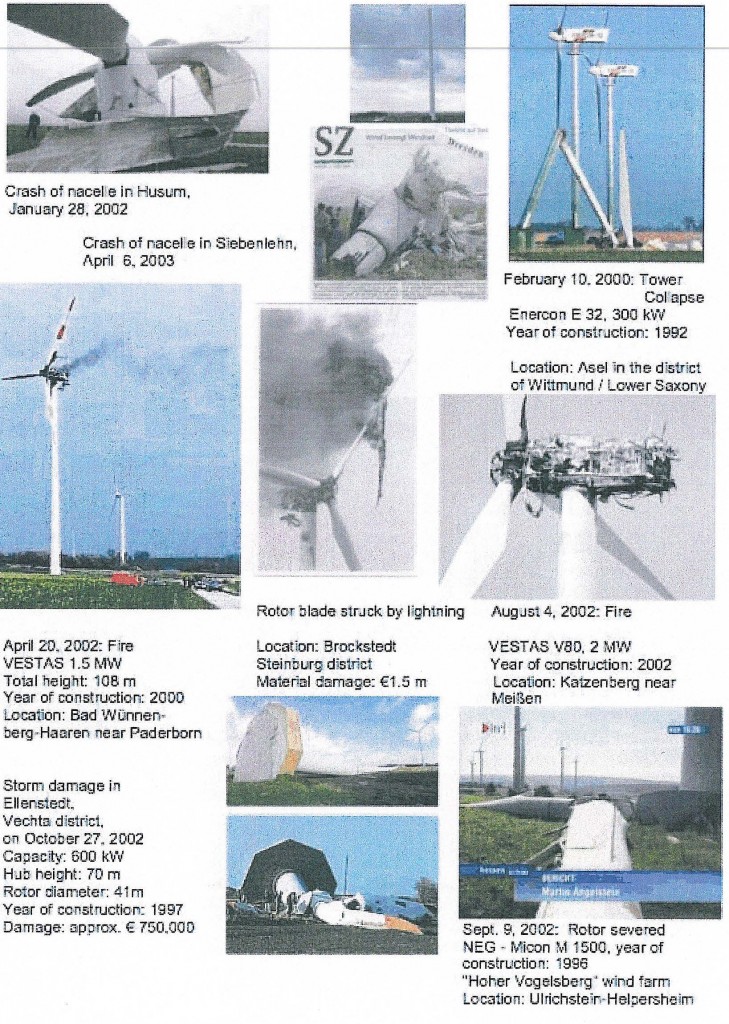
179_Montage of wind turbine catastrophic failures

179-1 Wind turbine blades after lightning strike
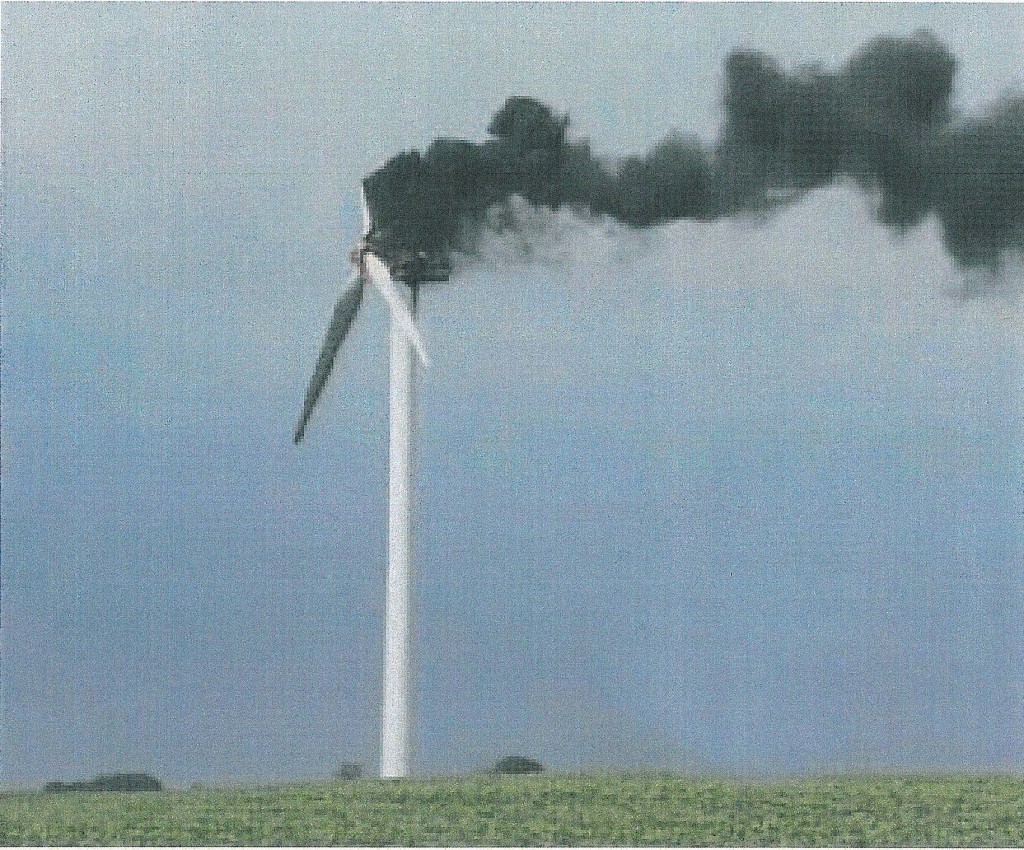
179 Wind turbine afire after lightning strike
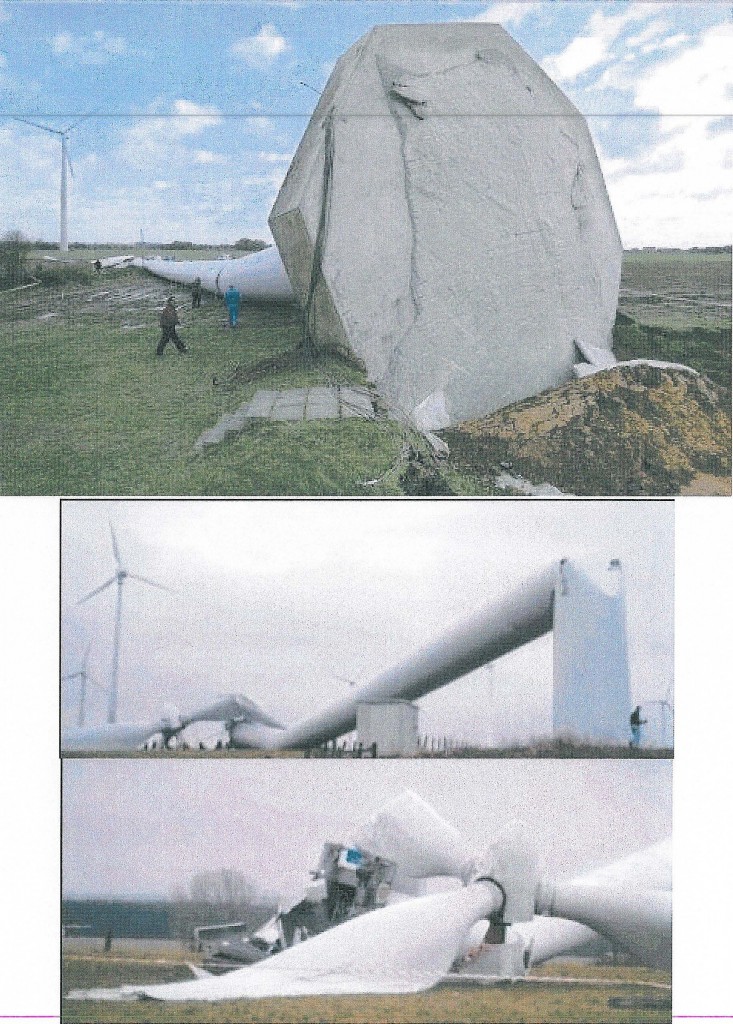
179. Wind turbine uprooted after windstorm
184. In spite of its relatively advantageous price, wind power is not likely to become a major source of energy because of its intermittent output, the need to build massive transmission lines to convey the energy to the regions which need it, environmental problems, and its impact on the transmission system itself.
Transmission systems and networks
185. The huge towers carrying high voltage transmission lines across the country, require heavy insulators and substantial ground clearance because air may be a good insulator, but it has its limits.
185.1 If the distance between the high voltage transmission cables is not great enough, the air may “break down” and sparking or arcing may occur. Moisture in the air makes breakdown easier, and designers of transmission lines have to provide for the worst possible atmospheric situation. Tall towers and wide rights-of-way have been the answer to the problem for almost a century.
186. For any type of power line, the amount of energy lost as heat to the resistance of the line increases as the amount of current fed through it is increased, and also as the line is lengthened. For a short line, these losses are small enough, but as the distances over which electric current must flow are increased, the heat loss becomes a significant fraction of the total energy transmitted. Some way must be found to carry the same amount of power, but reduce the heat lost, which depends on the current and the distance.
186.1 Increasing the voltage and reducing the current keeps the power the same but reduces the heat losses which depend on the current. Keeping the current as low as possible so the losses are low, and then raising the voltage as high as possible so that the product of voltage and current—the power&mdashremains high has been the basic philosophy of the American electric power industry since the time of George Westinghouse.
186.2 As the distances lengthen; the need for higher and higher voltages becomes evident. Transmission lines carrying voltages of 100,000 to 300,000 volts are common, and ones of over a million volts are under consideration.
186.3 The following photographic exhibit is a fair and accurate representation of high voltage transmission lines in Florida.
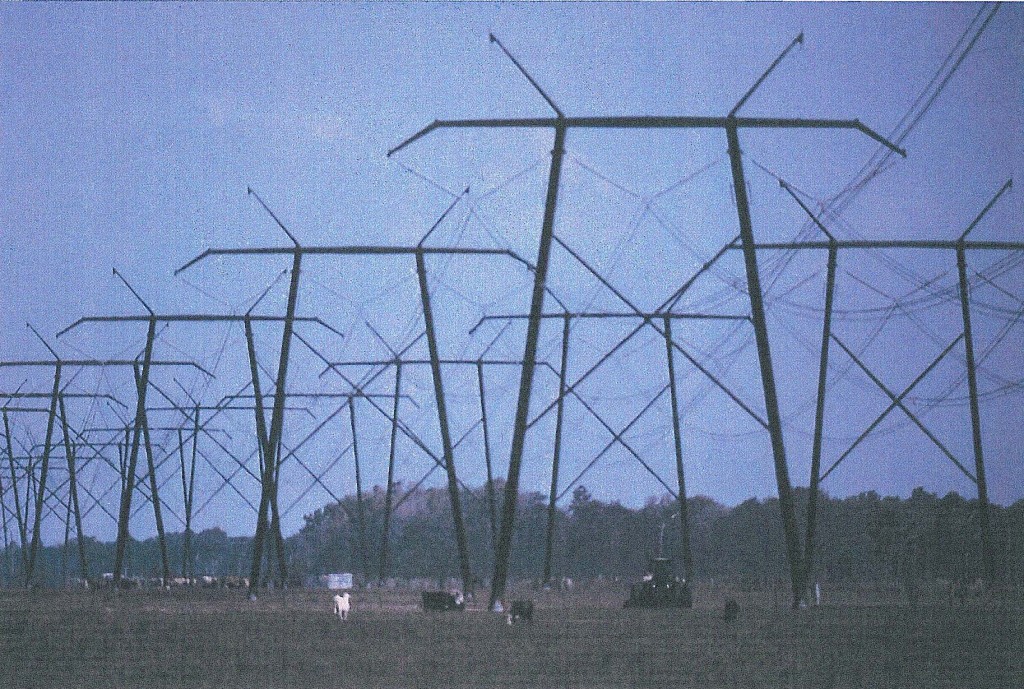
186.3 High Voltage transmission lines in Florida
187.1 The transmission line right-of-way needs to be kept free of vegetation to avoid fires and power outages and chemical mowing with herbicides is often employed.
188. A line used solely for transmitting power from a generating plant to a distant center of load or from one load center to another is a transmission line. The group of interconnected transmission lines that carries the energy at a high voltage is termed the transmission system. Transmission voltages usually range from 69,000 to 500,000 volts.
188.1 Transmission lines emanating from power plants usually form a network looping through various communities and to other power plants.
The “Grid”
189. The main transmission system of bulk power supply is the system of transmission lines interconnecting a company’s major power plants and the lines interconnecting with other power suppliers. Thus, the transmission system for bulk power supply is distinguished from the lower voltage transmission lines serving communities and industries and from the low-voltage distribution systems within the communities.
190. Electric power systems generally operate in two modes: (1) the steady-state or dynamic equilibrium condition and (2) the transient or unstable condition.
190.1 The condition of dynamic equilibrium is the desirable one. Unfortunately, power systems are always undergoing discrete changes in demand and supply and are subject to transmission-line interruptions and short circuits. To operate satisfactorily a system must absorb all of these disturbances and still remain in dynamic equilibrium. When ever a disturbance of any kind causes this equilibrium condition to be lost, the system becomes unstable and the result is usually a “blackout” .
190.2 Under normal conditions the system operates under several constraints, the most important one being that it must supply the entire consumer demand with minimum fluctuations in voltage and frequency. When a system cannot meet this requirement the result is a “brownout” .
190.3 Further, the system must operate at maximum possible efficiency and with minimum overall cost; that is, for a given demand situation the most economical generators must be on-line and the energy must be transmitted over those channels that introduce minimum loss.
190.4 On a larger scale, the same criteria apply to groups of individual utilities that are banded together in so-called “Interconnected Systems” or “Power Pools”, each organized as a separate entity serving a specific region.
190.5 Under emergency conditions it is sometimes possible for blocks of power to be moved from one region to another provided that elaborate pre-arrangements have been made.
190.6 Still another restraint on the development of large-scale power-pool interconnections is the technical limitation on the practical length of overhead AC transmission lines. Lines that are longer than 400 miles operate under severe stability and synchronization limits, and such ties are avoided in normal power system design. Similarly, underground a-c cables are even more restricted, with a maximum possible length of about 20 miles.
191. The lack of appropriate interconnection between the Southwest Power Pool (SPP) and Rocky Mountain Power Association (RMPA) power pools in western Kansas and eastern Colorado does not permit substantial growth in commercial wind energy development in Western Kansas where there would be fewer adverse cultural, historical and ecological impacts.
191.1 The following graphic exhibit is a fair and accurate schematic representation of growth in the Electric Grid System.
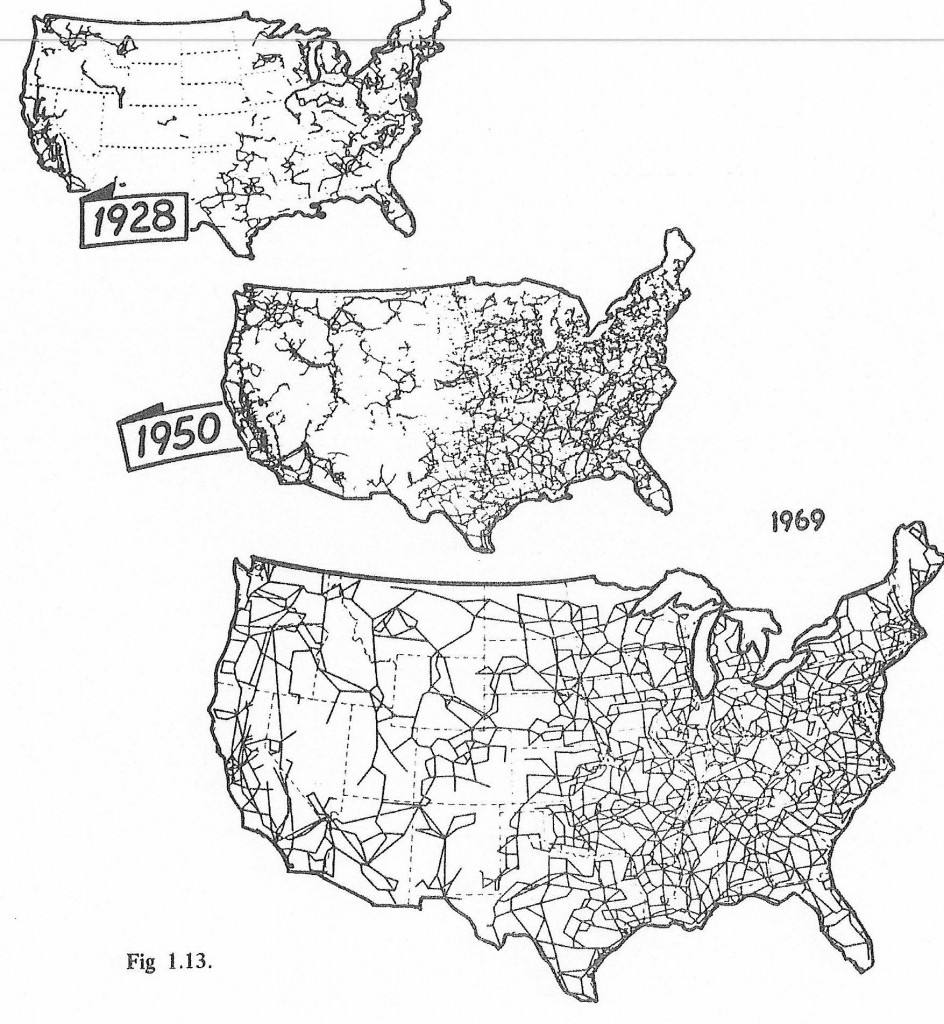
191.1 The Continental United States Elecdtric PowerGrid
193. Adding significant numbers of industrial wind turbine commercial electric power generation facilities will only increase the total costs of distributing whatever electric energy might be generated because of the regional sprawl that is required by industrial wind turbine siting constraints.
194. The ability of the existing transmission grid system to handle the heavy flows that occur only a few times during the year is decreasing. The nation’s transmission network is already the primary cause of power outages.
195. Upon information and belief, utility companies maintaining the electrical power grid must now meet a new requirement that the wires to the customer be available for delivering power produced by others who don’t maintain the delivery network.
196. Upon information and belief, In the case of industrial wind turbine commercial electric power generation facilities, the Federal Energy Regulatory Commission has placed the costs of distributing whatever small amounts of electric power the owners and operators of these industrial wind turbine commercial electric power generation facilities might generate on the owner of the transmission and distribution network-not the wind energy speculators. Traditionally, the cost of upgrading electrical transmission line systems are borne by those who create the need for such upgrades.
False and misleading claims by the corporate Defendants
197. The wind industry, the Department of Energy, its national laboratories, and other wind energy advocates have misled the public, the media, Congress and state legislators and regulators with their claims about the benefits of wind energy. They have greatly overstated the benefits and understated the true costs.
198. The wind industry and the corporate Defendants make false claims that industrial wind turbine commercial electric power generation facilities provide significant economic benefits in the areas and states where they are constructed as a result of capital investment, jobs, tax revenues, lease payments to landowners, and “other” economic activities.
199. Industrial wind turbine commercial electric power generation facilities produce few local economic benefits and whatever benefits might exist are overwhelmed by the higher true cost to the purchasers of the electric power produced by the industrial wind turbine commercial electric power generation facilities and the taxpayers who are forced to provide direct and indirect subsidies to the wind energy speculators.
200. Most of the jobs during construction of industrial wind turbine commercial electric power generation facilities last only a few months and are often filled by workers imported from outside the region affected.
200.1 Only 20 of 200 construction period jobs were filled by local workers in the case of the Top of Iowa industrial wind turbine commercial electric power generation facility built in 2001 and only 7 permanent jobs resulted.
201. Any of the putative economic benefits attributable to industrial wind turbine commercial electric power generation facilities will be much more than offset by:
201.1 The increase in electric customers’ monthly bills because electric power produced from wind is more expensive and that in the overall economic system, higher costs for electric power means that less money is available to consumers to spend for food, clothing, shelter, education, medical expenses and other needs reducing economic activity;
201.2 The cost of repairing roads damaged by the construction traffic and the continuing additional cost of government services particularly police, fire protection, and homeland security;
201.3 Other losses of economic activity, particularly tourism.
Please continue to the final section of the complaint, the prayer for relief
